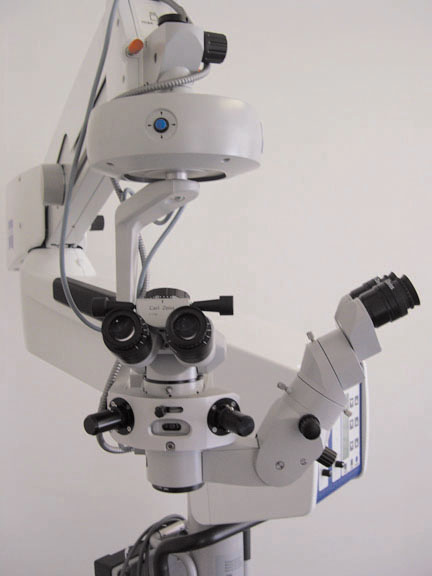
Everyone sees the world differently. But what if what you saw
was literally through someone else’s eyes?
An eye surgery that has been performed for more than 50 years
has made its way to Hazel Hawkins Hospital. Three weeks ago at
Hazel Hawkins, opthamologist Dr. Lawrence Birndorf performed the
first corneal transplant surgery
– a surgery that replaces someone’s faulty cornea with someone
else’s good cornea.
Everyone sees the world differently. But what if what you saw was literally through someone else’s eyes?
An eye surgery that has been performed for more than 50 years has made its way to Hazel Hawkins Hospital. Three weeks ago at Hazel Hawkins, opthamologist Dr. Lawrence Birndorf performed the first corneal transplant surgery – a surgery that replaces someone’s faulty cornea with someone else’s good cornea.
The cornea, which is the clear front part of the eye which you see through, can become scarred or contorted through injury or disease, Birndorf said.
“It’s like the window in front of the eye,” he said. “It’s when somebody has a problem that causes the cornea to become cloudy or distorted that we remove the circular central portion of the cornea and replace it with donor tissue that’s clear.”
In past years, the surgery was not performed at Hazel Hawkins because the equipment was not adequate, Birndorf said.
The hospital auxiliary rectified this problem by donating $110,000 for the purchase of a microscope and laser that enabled the hospital to finally offer it, said Frankie Valent, director of marketing at the hospital.
During a transplant the patient’s diseased cornea is removed and replaced with a clear cornea from a deceased organ donor, Birndorf said.
“It’s like a puzzle,” he said.
A surgical instrument called a “trephine,” which is a circular knife with a threaded screw mechanism on it, is used to cut out the patient’s cornea. This leaves a round opening in the eye – just empty space, Birndorf said.
A similar trephine is used to remove the donor cornea.
“You just push it, like a punch, that cuts out a circle (of tissue),” he said. “It’s like a cookie cutter. Then you lift that piece up, place it in the opening (of the patient’s eye) and suture it in.”
The sutures, or stitches, are extremely small – not even visible to the naked eye, and are made of nylon. When the new and clear cornea is placed on the patient’s eye, it takes about 20 stitches to sew it into place.
The stitches are usually never taken out because they become incorporated in the eye.
“They’re so fine and tiny that you can’t see them when you look,” Birndorf said, “unless you look with a microscope.”
The surgery takes about 45 minutes in its entirety, and the patient is awake the entire time.
Anesthesia is used to freeze the eye, which also freezes the optic nerve, so during the surgery the patient is temporarily blind in that eye, Birndorf said. Drapes are placed over the other eye for sterility, and medication is administered to keep the patient relaxed.
“There’s really nothing the patient can see,” he said. “It’s much safer this way because general anesthesia carries a lot of risks, and it’s easier on the patient. With local anesthesia we avoid all that.”
The after affects of the surgery are usually minor, with the patient able to go back to their full activities a few days after.
Their full, clear vision doesn’t usually return for about six months because it takes a long time for the cornea to heal, Birndorf said.
“I always tell patients not to be impatient,” he said. “I’ve had patients who I did transplants on as long as 25 years ago who still have nice, clear corneas.”
The surgery, which has more than a 90-percent success rate in most cases, is only performed if every other possibility of improving the patient’s vision has been taken into consideration, Birndorf said.
Because every surgery has risks associated with it, in order to perform the transplant the rewards must outweigh the risks. The greatest reward in this case is something many people take for granted every day – sight.
“Thousands of people every year lose vision only because of a bad cornea, and the rest of the eye is entirely healthy,” he said. “This is the only way that you bring back their vision under those circumstances.”
Several risks associated with the transplant are infection, hemorrhage and rejection, however these risks are small and very treatable, Birndorf said.
The risk for infection and hemorrhage are less than one percent, and while the risk that the patient’s eye will reject the donor cornea is more like 25 percent, there are many ways to combat this with medication and eye drops, Birndorf said.
“The odds are in the favor of the patients that they will do well,” he said.
The individual patient’s rewards from the surgery are obvious, but they can be felt on a much grander scale when you factor in the cost of taking care of someone who is blind on an socio-economic level, Birndorf said.
“In many cases the end result without the surgery is legal blindness – they can’t function,” he said. “If you can rehabilitate these people back to a level of vision where they can look after themselves, you can save our society huge amounts of money.”
The surgery costs around $7,000 between the surgeon’s fee and the hospital’s fee, but much of it can be covered under one’s insurance, he said.
The second corneal transplant at Hazel Hawkins is already scheduled for Thursday, and the patient who had the surgery several weeks ago is doing extremely well, Birndorf said.
“She’s terrific,” he said. “She could not be doing better.”









